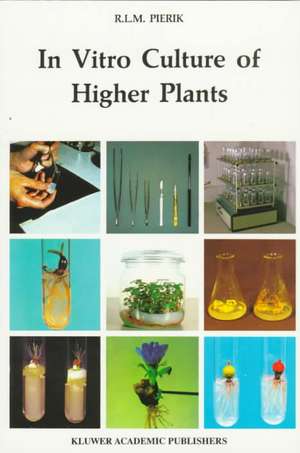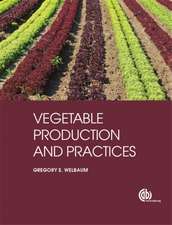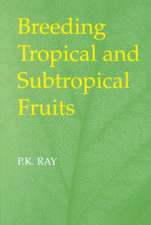In Vitro Culture of Higher Plants
Autor R. L. M. Pieriken Limba Engleză Paperback – 30 iun 1997
Typical methodological aspects are given in the first part: laboratory set-up, composition and preparation of media, sterilization of media and plant material, isolation and (sub)culture, mechanization, the influence of plant and environmental factors on growth and development, the transfer from test-tube to soil, aids to study. The question of why in vitro culture is practised is covered in the second part: embryo culture, germination of orchid seeds, mericloning of orchids, production of disease-free plants, vegetative propagation, somaclonal variation, test-tube fertilization, haploids, genetic manipulation, other applications in phytopathology and plant breeding, secondary metabolites.
Preț: 1132.67 lei
Preț vechi: 1381.31 lei
-18% Nou
Puncte Express: 1699
Preț estimativ în valută:
216.74€ • 226.86$ • 180.39£
216.74€ • 226.86$ • 180.39£
Carte tipărită la comandă
Livrare economică 31 martie-14 aprilie
Preluare comenzi: 021 569.72.76
Specificații
ISBN-13: 9780792345275
ISBN-10: 0792345274
Pagini: 348
Ilustrații: V, 348 p.
Dimensiuni: 160 x 240 x 19 mm
Greutate: 1.13 kg
Ediția:Softcover reprint of the original 1st ed. 1997
Editura: SPRINGER NETHERLANDS
Colecția Springer
Locul publicării:Dordrecht, Netherlands
ISBN-10: 0792345274
Pagini: 348
Ilustrații: V, 348 p.
Dimensiuni: 160 x 240 x 19 mm
Greutate: 1.13 kg
Ediția:Softcover reprint of the original 1st ed. 1997
Editura: SPRINGER NETHERLANDS
Colecția Springer
Locul publicării:Dordrecht, Netherlands
Public țintă
ResearchCuprins
2. Introduction.- 2.1. Outline.- 2.2. Abbreviations and glossary.- 3. History.- 3.1. Introduction.- 3.2. Developments in the Netherlands and other countries.- 4. Types of cultures.- 5. Laboratory equipment.- 5.1. Supplies.- 5.2. The laminar air-flow cabinet.- 5.3. Sterilization of nutrient media.- 5.4. Preparation room.- 5.5. Cleaning glassware.- 5.6. Robots in the plant tissue culture laboratory.- 6. Preparation and composition of nutrient media.- 6.1. Introduction.- 6.2. Glassware and plastics.- 6.3. Preparation.- 6.4. Composition.- 6.5. Commercially prepared media.- 6.6. Storage of nutrient media.- 7. Closure of test tubes and flasks.- 8. Care of plant material.- 9. Sterilization of plant material.- 9.1. Introduction.- 9.2. Chemical sterilization.- 9.3. Apparently sterile cultures.- 9.4. Internal infections.- 9.5. Symbiotic cultures.- 10. Isolation, inoculation and subculturing.- 10.1. Introduction.- 10.2. Isolation.- 10.3. Inoculation.- 10.4. Subculturing.- 11. Mechanization.- 12. The influence of plant material on growth and development.- 13. The influence of physical factors on growth and development.- 13.1. The culture room.- 13.2. Discussion of special physical factors.- 14. The transfer from nutrient medium to soil.- 15. Aids to study.- 15.1. Literature study.- 15.2. Societies and associations.- 15.3. Laboratory notebook, photographs and slides.- 16. Embryo culture.- 16.1. Introduction.- 16.2. Techniques.- 16.3. Factors affecting the success of embryo culture.- 16.4. Practical applications.- 17. Germination of orchid seeds.- 17.1. Introduction.- 17.2. Factors affecting germination and growth.- 18. Vegetative propagation of orchids.- 18.1. Introduction.- 18.2. Meristem culture.- 18.3. Other methods of propagation.- 18.4. Variation arising during culture.- 18.5.Practical applications.- 19. Production of disease-free plants.- 19.1. Introduction.- 19.2. Production of virus-free plants.- 19.3. Production of bacteria- and fungal-free plants by meristem culture.- 20. Vegetative propagation.- 20.1. General introduction.- 20.2. Single-node culture.- 20.3. The axillary bud method.- 20.4. Regeneration of explants.- 20.5. Callus induction, callus culture and regeneration of organs and embryos.- 20.6. Regeneration of plants from single cells.- 20.7. Synthetic seeds.- 21. Somaclonal variation.- 22. Test tube fertilization.- 23. Production of haploids.- 23.1. General introduction.- 23.2. Obtaining haploids in vitro.- 23.3. Problems associated with haploid induction.- 24. Genetic manipulation.- 24.1. General introduction.- 24.2. Description.- 24.3. Prerequisites for the use of genetic manipulation.- 24.4. Somatic hybridization.- 24.5. The relevance of somatic hybridization.- 24.6. Disadvantages and problems of somatic hybridization.- 24.7. Selection procedures after somatic hybridization.- 24.8. Selection of mutants.- 24.9. Transformation by Agrobacterium tumefaciens.- 25. Miscellaneous applications.- 25.1. In phytopathology.- 25.2. In plant breeding.- 25.3. The biosynthesis of substances in vitro.- 26. In vitro cloning of plants in the Netherlands.- 27. Index.- 28. Literature cited.







